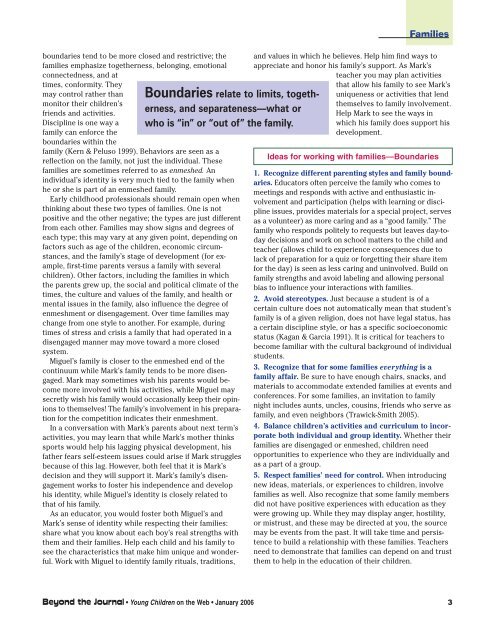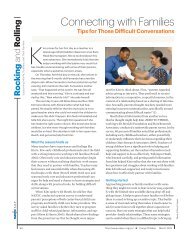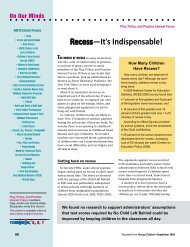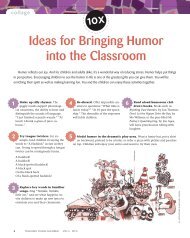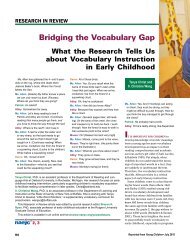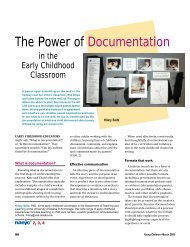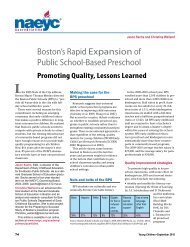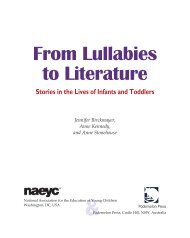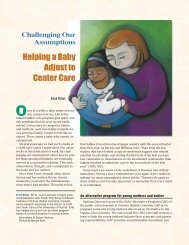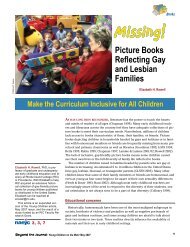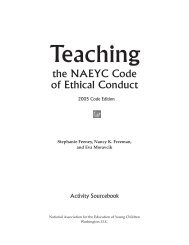Understanding Families - National Association for the Education of ...
Understanding Families - National Association for the Education of ...
Understanding Families - National Association for the Education of ...
Create successful ePaper yourself
Turn your PDF publications into a flip-book with our unique Google optimized e-Paper software.
oundaries tend to be more closed and restrictive; <strong>the</strong><br />
families emphasize toge<strong>the</strong>rness, belonging, emotional<br />
connectedness, and at<br />
times, con<strong>for</strong>mity. They<br />
Boundaries relate to limits, toge<strong>the</strong>rness,<br />
and separateness—what or<br />
who is “in” or “out <strong>of</strong>” <strong>the</strong> family.<br />
may control ra<strong>the</strong>r than<br />
monitor <strong>the</strong>ir children’s<br />
friends and activities.<br />
Discipline is one way a<br />
family can en<strong>for</strong>ce <strong>the</strong><br />
boundaries within <strong>the</strong><br />
family (Kern & Peluso 1999). Behaviors are seen as a<br />
reflection on <strong>the</strong> family, not just <strong>the</strong> individual. These<br />
families are sometimes referred to as enmeshed. An<br />
individual’s identity is very much tied to <strong>the</strong> family when<br />
he or she is part <strong>of</strong> an enmeshed family.<br />
Early childhood pr<strong>of</strong>essionals should remain open when<br />
thinking about <strong>the</strong>se two types <strong>of</strong> families. One is not<br />
positive and <strong>the</strong> o<strong>the</strong>r negative; <strong>the</strong> types are just different<br />
from each o<strong>the</strong>r. <strong>Families</strong> may show signs and degrees <strong>of</strong><br />
each type; this may vary at any given point, depending on<br />
factors such as age <strong>of</strong> <strong>the</strong> children, economic circumstances,<br />
and <strong>the</strong> family’s stage <strong>of</strong> development (<strong>for</strong> example,<br />
first-time parents versus a family with several<br />
children). O<strong>the</strong>r factors, including <strong>the</strong> families in which<br />
<strong>the</strong> parents grew up, <strong>the</strong> social and political climate <strong>of</strong> <strong>the</strong><br />
times, <strong>the</strong> culture and values <strong>of</strong> <strong>the</strong> family, and health or<br />
mental issues in <strong>the</strong> family, also influence <strong>the</strong> degree <strong>of</strong><br />
enmeshment or disengagement. Over time families may<br />
change from one style to ano<strong>the</strong>r. For example, during<br />
times <strong>of</strong> stress and crisis a family that had operated in a<br />
disengaged manner may move toward a more closed<br />
system.<br />
Miguel’s family is closer to <strong>the</strong> enmeshed end <strong>of</strong> <strong>the</strong><br />
continuum while Mark’s family tends to be more disengaged.<br />
Mark may sometimes wish his parents would become<br />
more involved with his activities, while Miguel may<br />
secretly wish his family would occasionally keep <strong>the</strong>ir opinions<br />
to <strong>the</strong>mselves! The family’s involvement in his preparation<br />
<strong>for</strong> <strong>the</strong> competition indicates <strong>the</strong>ir enmeshment.<br />
In a conversation with Mark’s parents about next term’s<br />
activities, you may learn that while Mark’s mo<strong>the</strong>r thinks<br />
sports would help his lagging physical development, his<br />
fa<strong>the</strong>r fears self-esteem issues could arise if Mark struggles<br />
because <strong>of</strong> this lag. However, both feel that it is Mark’s<br />
decision and <strong>the</strong>y will support it. Mark’s family’s disengagement<br />
works to foster his independence and develop<br />
his identity, while Miguel’s identity is closely related to<br />
that <strong>of</strong> his family.<br />
As an educator, you would foster both Miguel’s and<br />
Mark’s sense <strong>of</strong> identity while respecting <strong>the</strong>ir families:<br />
share what you know about each boy’s real strengths with<br />
<strong>the</strong>m and <strong>the</strong>ir families. Help each child and his family to<br />
see <strong>the</strong> characteristics that make him unique and wonderful.<br />
Work with Miguel to identify family rituals, traditions,<br />
<strong>Families</strong><br />
and values in which he believes. Help him find ways to<br />
appreciate and honor his family’s support. As Mark’s<br />
teacher you may plan activities<br />
that allow his family to see Mark’s<br />
uniqueness or activities that lend<br />
<strong>the</strong>mselves to family involvement.<br />
Help Mark to see <strong>the</strong> ways in<br />
which his family does support his<br />
development.<br />
Ideas <strong>for</strong> working with families—Boundaries<br />
1. Recognize different parenting styles and family boundaries.<br />
Educators <strong>of</strong>ten perceive <strong>the</strong> family who comes to<br />
meetings and responds with active and enthusiastic involvement<br />
and participation (helps with learning or discipline<br />
issues, provides materials <strong>for</strong> a special project, serves<br />
as a volunteer) as more caring and as a “good family.” The<br />
family who responds politely to requests but leaves day-today<br />
decisions and work on school matters to <strong>the</strong> child and<br />
teacher (allows child to experience consequences due to<br />
lack <strong>of</strong> preparation <strong>for</strong> a quiz or <strong>for</strong>getting <strong>the</strong>ir share item<br />
<strong>for</strong> <strong>the</strong> day) is seen as less caring and uninvolved. Build on<br />
family strengths and avoid labeling and allowing personal<br />
bias to influence your interactions with families.<br />
2. Avoid stereotypes. Just because a student is <strong>of</strong> a<br />
certain culture does not automatically mean that student’s<br />
family is <strong>of</strong> a given religion, does not have legal status, has<br />
a certain discipline style, or has a specific socioeconomic<br />
status (Kagan & Garcia 1991). It is critical <strong>for</strong> teachers to<br />
become familiar with <strong>the</strong> cultural background <strong>of</strong> individual<br />
students.<br />
3. Recognize that <strong>for</strong> some families everything is a<br />
family affair. Be sure to have enough chairs, snacks, and<br />
materials to accommodate extended families at events and<br />
conferences. For some families, an invitation to family<br />
night includes aunts, uncles, cousins, friends who serve as<br />
family, and even neighbors (Trawick-Smith 2005).<br />
4. Balance children’s activities and curriculum to incorporate<br />
both individual and group identity. Whe<strong>the</strong>r <strong>the</strong>ir<br />
families are disengaged or enmeshed, children need<br />
opportunities to experience who <strong>the</strong>y are individually and<br />
as a part <strong>of</strong> a group.<br />
5. Respect families’ need <strong>for</strong> control. When introducing<br />
new ideas, materials, or experiences to children, involve<br />
families as well. Also recognize that some family members<br />
did not have positive experiences with education as <strong>the</strong>y<br />
were growing up. While <strong>the</strong>y may display anger, hostility,<br />
or mistrust, and <strong>the</strong>se may be directed at you, <strong>the</strong> source<br />
may be events from <strong>the</strong> past. It will take time and persistence<br />
to build a relationship with <strong>the</strong>se families. Teachers<br />
need to demonstrate that families can depend on and trust<br />
<strong>the</strong>m to help in <strong>the</strong> education <strong>of</strong> <strong>the</strong>ir children.<br />
Beyond <strong>the</strong> Journal Young Children on <strong>the</strong> Web January 2006 3


